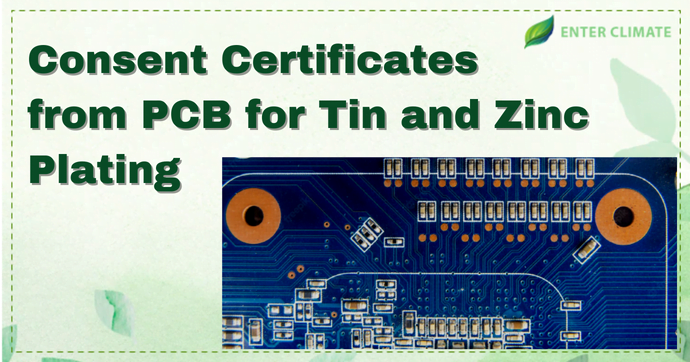Consent Certificates from PCB for Tin and Zinc Plating
 06 Dec, 2022
06 Dec, 2022 
Electroplating is the electrochemical process in which a uniform layer of the desired metal is coated with the help of a redox reaction with a base metal surface that imparts some unique characteristics like corrosion resistance, chemical inertness, lustre, and electrical or heat conductivity to the base metal. Tin and zinc plating have been gaining popularity among today’s entrepreneurs because of the high demand for electroplated items and the ease of setting up this business. As all metal electroplating businesses use similar techniques for different metals with slight tweaking of the process for different metals (nickel, chrome, gold, platinum, silver etc.), units that use tin and zinc can also expand their business later to include other metals in the same facility. However, the tin and zinc plating business will need Consent Certificates from the SPCB or the Pollution Control Committee(PCC) for the waste they generate in the process. Also, the unit owner must seek this permission from the Board before starting the operation. This article will take you through the process of obtaining the NOC from the Pollution Control Board and the associated legalities and post-compliance involved in running a tin and zinc electroplating unit.
Tin and Zinc Plating as a business in India
Tin and Zinc plating units in India perform the same process using different mechanisms in the same facility. These include:-
- Electropolishing
- Electroless Plating
- Industrial Metal Finishing
- Galvanising Of Zinc
- Hot Dip Galvanizing
- Tin and Zin Alloy coating
Advantages of starting the Tin and Zinc Plating Business
The process involves the application of direct electric current (DC) through the bath solution that causes the migration of positive anions towards the negative cathode and negative actions towards the positive anode. The item to be coated is immersed in the bath solution as the cathode and the coating substance. The process is exothermic and leads to the elevation of the temperature of the bath.
Advantages of Tin Plating Business
- The tin plating process involves depositing a solderable tin coating onto a material’s surface. Tin plating can be applied to regular steel, stainless steel, copper, brass, aluminium, and zinc die-cast.
- Tin can also produce a shiny, metallic look when lustre is preferred.
- Tin offers decent conductivity, making it useful in the plating of various electronic components.
- Tin is inexpensive when compared to other metals. Manufacturers generally opt for tin plating instead of other metals.
- Tin electrodeposits can produce a whitish-grey colour that is preferable when a dull or matte appearance is desired.
- Tin has many advantages like malleability, excellent solderability and easy availability, making it a desirable choice.
- It reduces metal corrosion due to fretting, which means deterioration of the metal surface at the interface of two contacting surfaces.
- Tin plating has the potential to give a mirror-like finish if done correctly. Tin also provides flexibility to use matte (tin) plating for a dull finish.
- As tin has no known toxicity to living organisms, the contamination of resources with tin is not threatening.
Advantages of Zinc Plating Business
Zinc is usually alloyed with other metal types, which leads to better performance compared to the situation when zinc is plated alone. The advantages of using zinc for electroplating are
- Zinc is one of the easily available metals, and therefore the input cost in the business is also less.
- Zinc is a perfect alternative to deliver a protective coating to metal accessories such as fasteners, bolts, nuts, and automotive parts.
- It can also enhance the appearance of metal components by giving them a range of colours, brightness, and elegant shine.
- Zinc plating is often utilised for plating nuts, bolts and metal brackets as it provides an even finish.
- Followed by passivation, zinc plating can enhance resistance to red and white rusting, as well as other corrosive processes on metal surfaces due to environmental pollution.
- Zinc and its alloys are utilised in the automotive industry to plate essential components like engine parts, brake components, power steering etc.
- Zinc plating is also found in construction applications such as scaffolding.
Process of Acquiring Consent Certificate from PCB for Tin and Zinc Plating
As with any other electroplating facility, the application to acquire a Consent certificate for tin and zinc plating has to be made to the concerned SPCB/PCC. This process has three stages, i.e. submission of online application, document scrutiny and issuance of pollution NOC. A consent certificate is mandatory under the Air and Water Act. It is issued in 2 stages, i.e. Consent to Establish (CTE)[1], which is a pre-establishment NOC, and Consent to Operate (CTO). CTE is required only once so that the Pollution Control Board can ascertain applicable rules w.r.t the facility’s location, land use classification, industrial waste treatment, registration of the unit, etc. However, CTO has to be renewed periodically, requiring the facility to follow the given post-compliance provisions mentioned in the issued CTO. The details of the stages in the application process are
Stage 1:Application and fee Submission
To obtain Consent NOC, the tin and zinc plating unit must apply to their concerned SPCB/PCC through their respective Online Consent Management and Monitoring System. After submitting the stipulated application fee, all necessary documents must be uploaded to the portal. The documents to be submitted include
- A covering letter for requisition showing the status of the industry and activities clearly.
- Attested copy of the sale Deed or Lease Deeds along with other relevant documents to ensure site possession.
- Attested copy of Memorandum of Articles in case of Public/Private unit or registered partnership deed (for partnership company).
- Layout plan showing the location of various process equipment and utilities like generator, boiler, effluent treatment plant, and hazardous and non-hazardous waste storage area.
- Schematic diagram depicting the distance of the tin and zinc plating unit from proposed residential areas, water bodies, roads, important religious locations, agricultural land, educational institutions, monuments, and sensitive areas.
- Details of the manufacturing process.
- Water Balance details, Groundwater clearance (If applicable)
- Material balance Details for each product and process.
- Certificate to prove Land use classification.
- Auditor’s Certificate showing the break-up details for proposed Gross fixed Assets duly, which must be certified by a CA along with the financial provisions for pollution control.
- Consent fee
- Detailedlayoutdrawing of STP and diagram for the hydraulic profile, mode of disposal of treated sewage and its adequacy (If applicable).
Stage 2:Document Scrutiny and Site Inspection
After documents have been scrutinised, a site inspection is scheduled. The site inspection official visits the tin and zinc plating unit after the facility has been set up. Here pollution discharge samples (air and water) and the installed pollution control measures at the facility are inspected.
Stage 3: Issue of Pollution NOC
If the inspection report prepared by the site inspector is satisfactory, the Board will issue the Consent Certificate within 120 days of the submission of the complete form. The issuing authority is the Chairman or the Member Secretary of the concerned SPCB/PCC.
Conclusion
Because electroplating with tin and zinc produces coatings that excel in resisting corrosion and increasing solderability, this method has attracted attention in the electroplating market in recent times. Tin and zinc are applied individually or as alloys in electroplating automobile parts and electronic components. Alkali cyan baths, borofluoride baths, sulfonic acid baths, pyrophosphoric acid baths, carboxylic acid baths etc., are used as plating baths in electroplating with tin and zinc plating as well as tin-zinc alloys. These chemicals used in electroplating baths are, however, toxic and, therefore, must not be discarded without proper treatment.
Categories
Latest Post
Air pollution Dispersion Modeling
Natural Disaster Risk Assessment
Endangered Species Protection
Aquifer Recharge Project
Sustainable Sanitation Solutions














